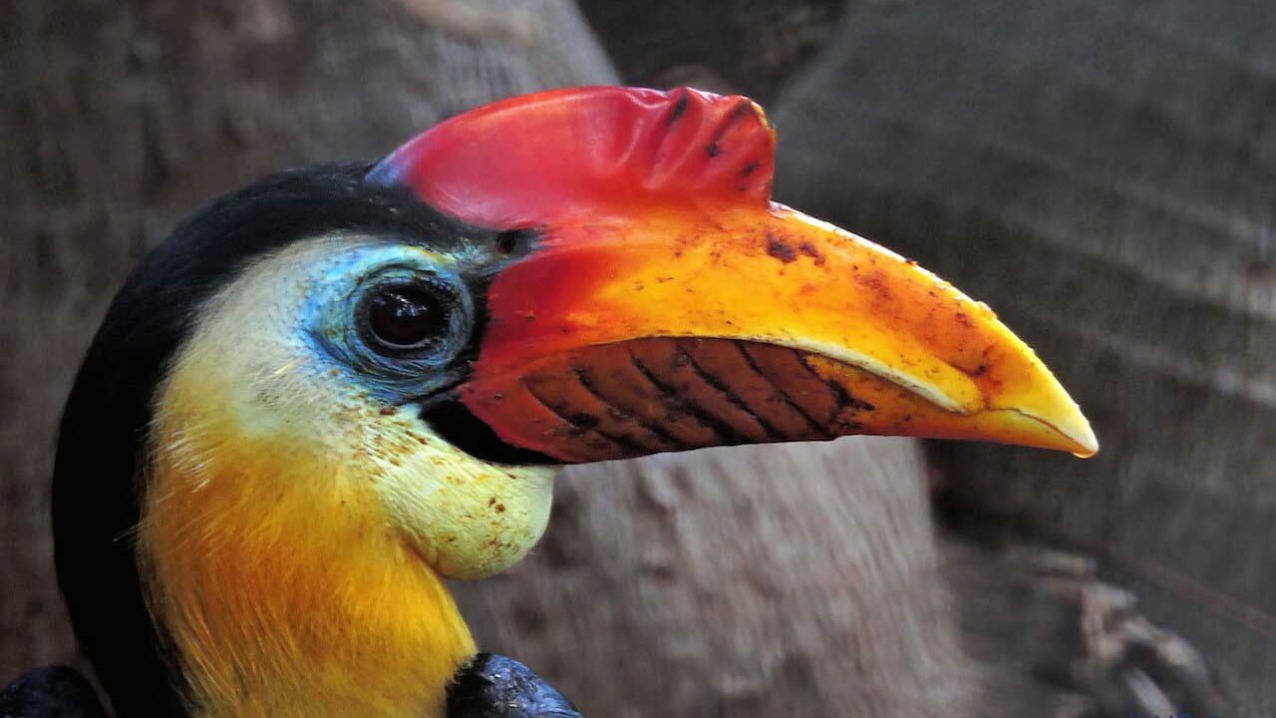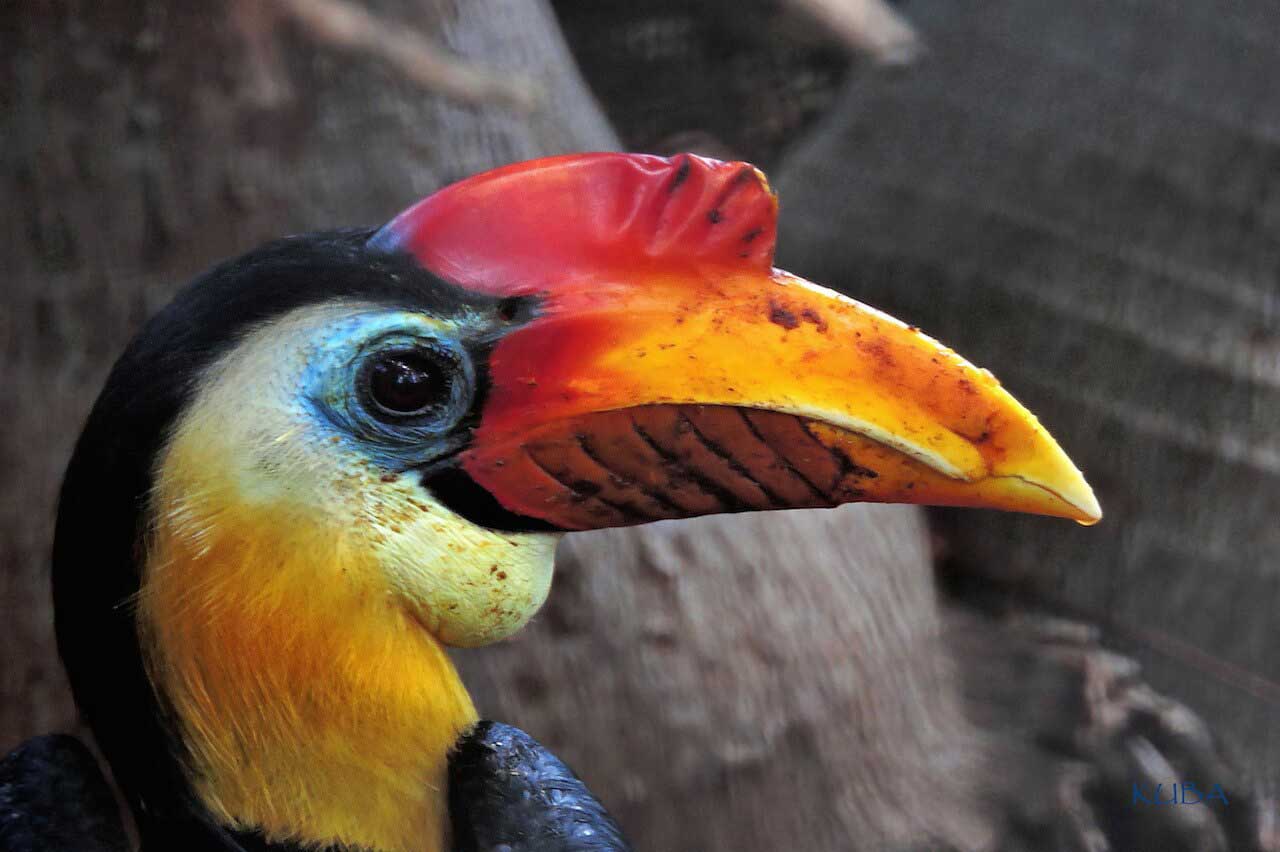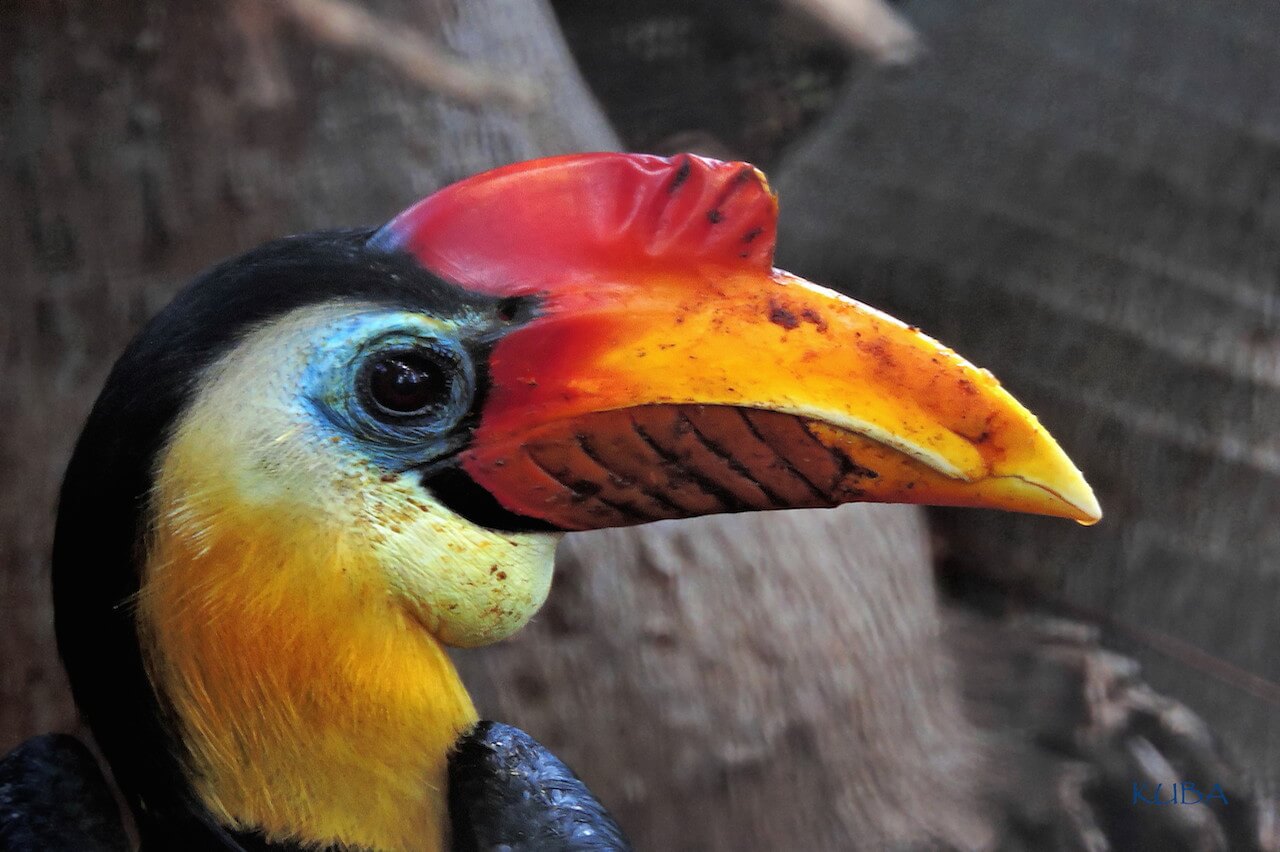aceros corrugatus
Wrinkled Hornbill
About Me
Scientific Name: Aceros corrugatus
Description
Wrinkled hornbills are medium-sized birds about 65-75 cm in height. They have black plumage and a white or yellow stained tail with a black base. Their wings have ten rounded primaries that allow air to go through creating a loud whooshing sound that some say sounds like a train or a storm. Males have yellow feathering on their inflatable throats, chests, and face.
Fun Facts
- Hornbills get their name from this unique bill. The bill is used to grasp and toss insects and fruits in the air to eat.
- They have a life long relationship like married couples and usually breed during rainy seasons when moist soil is available to build nest walls.
- Kingdom: Animalia
- Phylum: Chordata
- Class: Aves
- Order: Bucerotiformes
Wrinkled hornbills are medium-sized birds about 65-75 cm in height. They have black plumage and a white or yellow stained tail with a black base. Their wings have ten rounded primaries that allow air to go through creating a loud whooshing sound that some say sounds like a train or a storm. Males have yellow feathering on their inflatable throats, chests, and face. Blue skin covers the eye area. Females do not have yellow coloring on their chest or face, but they have blue skin that covers the face and throat area. Their bills are very large and yellow with a casque that looks like an extra beak. The casque is curved with ridges and sits on top the bill. A males casque is usually red or orange in color and females have a slightly smaller, yellow casque. Hornbills get their name from this unique bill. The bill is used to grasp and toss insects and fruits in the air to eat. Other uses for the bill include helping to build and maintain the nest, aiding in defense against poisonous snakes and other predators, sound reception, and it can be used to determine their age. The bill is very powerful because it is fused to the cranium, which in turn articulates with the fused upper vertebrae. This creates a pickax-like beak that is very useful for the young to peck out of the nest.
Hornbills are usually found in the evergreen forests of the lowlands, up to an altitude of 1000 meters. They can be found in Thailand, Malaysia, and Borneo. The distribution of hornbills can be correlated with the characteristics of the forests such as large trees with natural tree cavities used for nesting and fig-tree density for food. For that reason, hornbills are more likely to be found in unlogged forests.
The monogamous Wrinkled Hornbills are usually found in pairs or in small groups. They are not aggressive and are sometimes clumsy in flight. They have deep echoing calls that sound like harsh kak-kak or deep rowwow or wakowwakowkow and calls can be heard from miles away. They have a life long relationship like married couples and usually breed during rainy seasons when moist soil is available to build nest walls. They do not have the typical bird nesting behavior. Instead of building nests out of twigs, they find a tree hole. The hole is constructed by a woodpecker pecking a hole in the tree. Eventually fungus will grow and enlarge the hole. Bees are attracted to the hole and use the hole to make honey. The honey attract a bear that uses his claws to dig out the honey, further enlarging the hole, making it a perfect nesting site for the wrinkled hornbill. After finding a good nest hole, the female will do most of the nest building by blocking the entry of a tree cavity with a plaster made with mud, droppings, and regurgitated food. The male will bring all the materials needed and finish the outer wall where the female can no longer reach. The main purpose of this wall is to protect the eggs from predators such as monkeys, and snakes. A small hole is left so the male can feed his family, and the female stays locked in the nest with the eggs during incubation period. The incubation period is usually 28-30 days. After a few months the female will break out of the nest, and the chicks will rebuild the wall and continue to be fed by the male until they are ready to leave the nest.
Hornbills eat mostly fruits with numerous small fine seeds such as figs, and small animals such as frogs, lizards, snails, arthropods and young birds. During the nesting period, the male will regurgitate up to 150 figs to feed to his family. These birds do not rely on drinking water because they get water from their food. If the male brings the same food, the female will throw the food back suggesting that he find something else. If the male were never to return, his mate and chicks would starve to death.
Breeding is usually during the rainy season of December and January. Nest holes are usually located 40-50 meters above ground. After a pre-laying period of 4-6 days, the female will lay an average of two eggs. She can lay extra eggs if the eggs are lost. After a month of incubation, the chicks will hatch. They have pink skin that will turn purple in about 10 days. This is when the female breaks out of the nest, and the male continues to feed the chicks. The chicks will mature and leave the nest after another 65-73 days. The whole nesting cycle takes about four months.
Wrinkled Hornbills are common in North Sarawak, Brunei, and South Sumatra, but are rare in Peninsular Malaysia. In Thailand, they are considered an endangered species. Their near extinct status is from the widespread destruction of the rain forest, the lack of suitable breeding sites, and from being hunted. In Northern Borneo hornbills are hunted for their tail feathers that are used to make traditional costumes for ceremonies. Villagers will pay a high price for a baby hornbill and this trade contributes to the continued decrease of these birds. There are organizations that have adoption projects to protect these birds from being hunted. Wrinkled Hornbills have the largest number of individuals in captivity for the hornbill family, as listed in the North American regional studbook.
del Hoyo, J., Elliott, A. & Sargatal, J. Handbook of the World. Vol. 6. Mousebirds to Hornbills. Lynx Edicions, Barcelona, 2001
Lekagul, B., Round, P. A Guide to the Birds of Thailand. Saha Karn Bhaet Co., Ltd. Publisher, 1991.
Poonswad, P. The Asian Hornbills: Ecology and Conservation. Thai studies in Biodiversity, No. 2: 1-336, Editor, 1999.
Sanft, K. The Coraciiformes. Grzimeks Animal Life Encyclopedia. Vol. 9, Birds III. 1973.
Kowalczyk, E. Sunda Wrinkled Hornbill- Aceros Corrugatus. Woodland Park Zoological Gardens. 10 Mar. 2002.
Other Birds
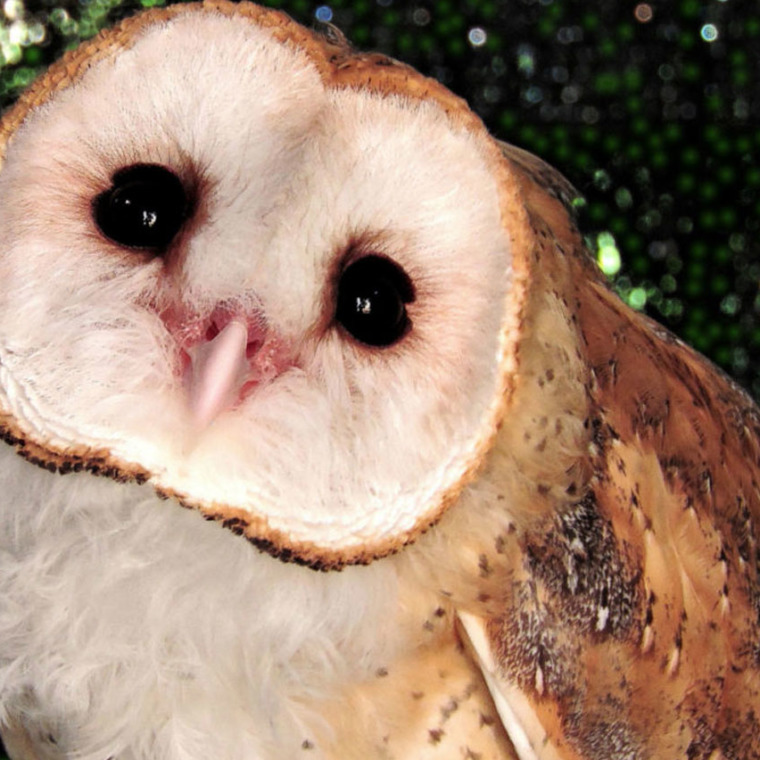
Barn Owls are found throughout the globe, in Europe, Africa, Asia, Austrailia, and the Americas
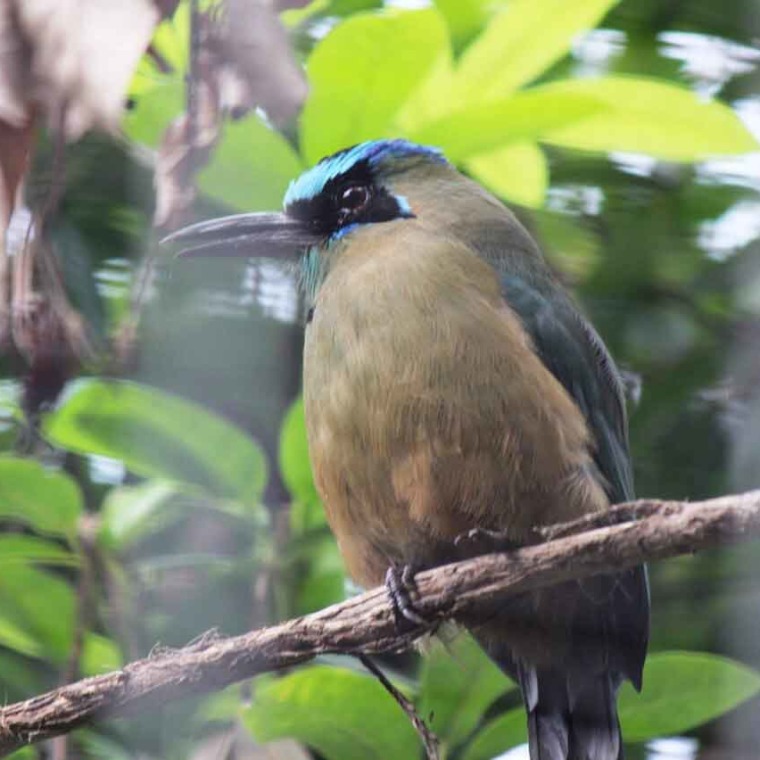
This animal can grow over a foot in length! Motmots possess a serrated beak and red eyes, with a black mask that encircles their heads.
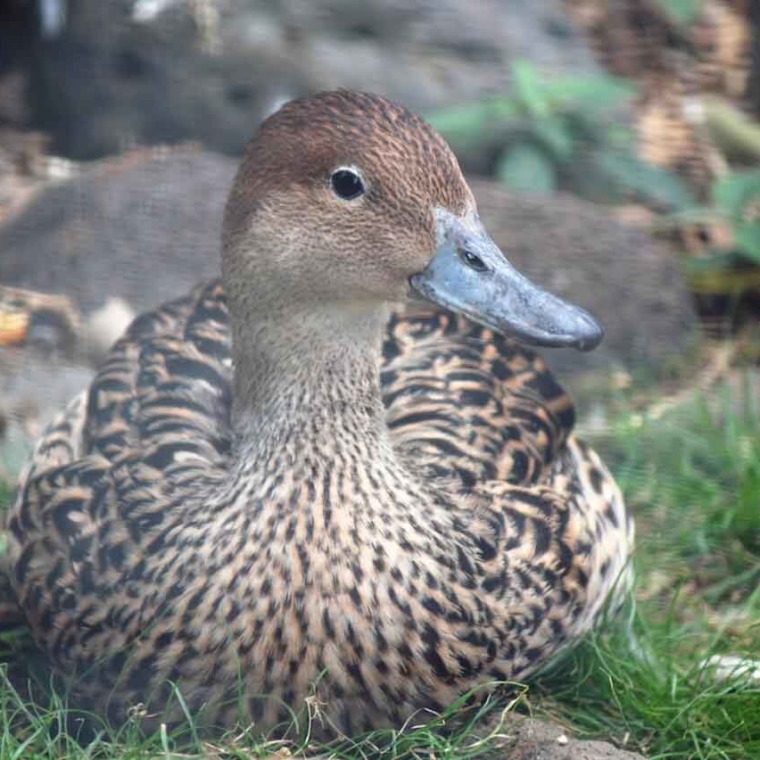
Koloa maoli are very secretive and difficult to observe except in protected areas such as Hanalei National Wildlife Refuge on Kauai.
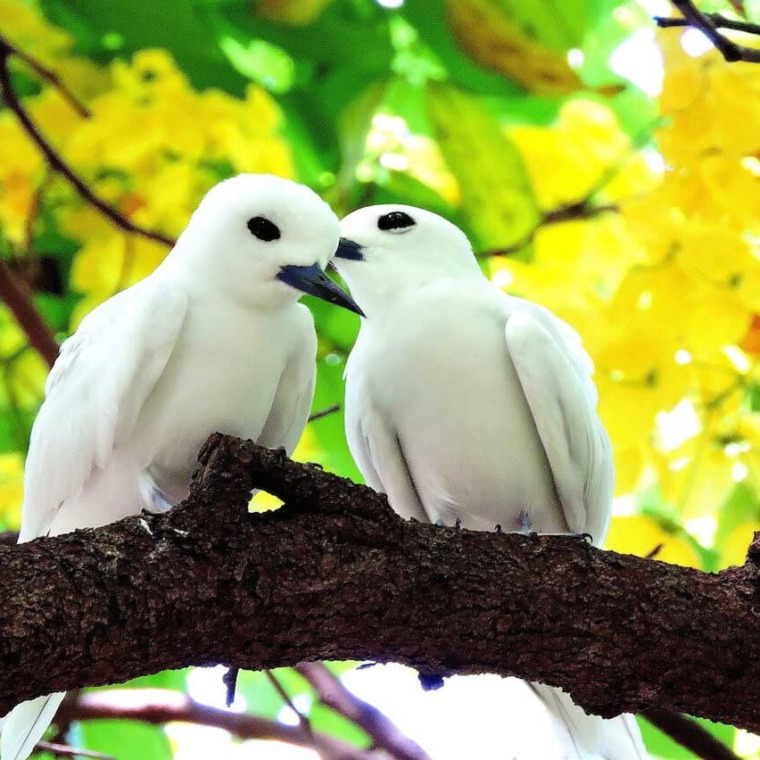
This bird is found primarily on islands, and has a wide ranger across the equatorial band of every ocean on Earth, save for the Arctic Ocean, which does not cross the equator.
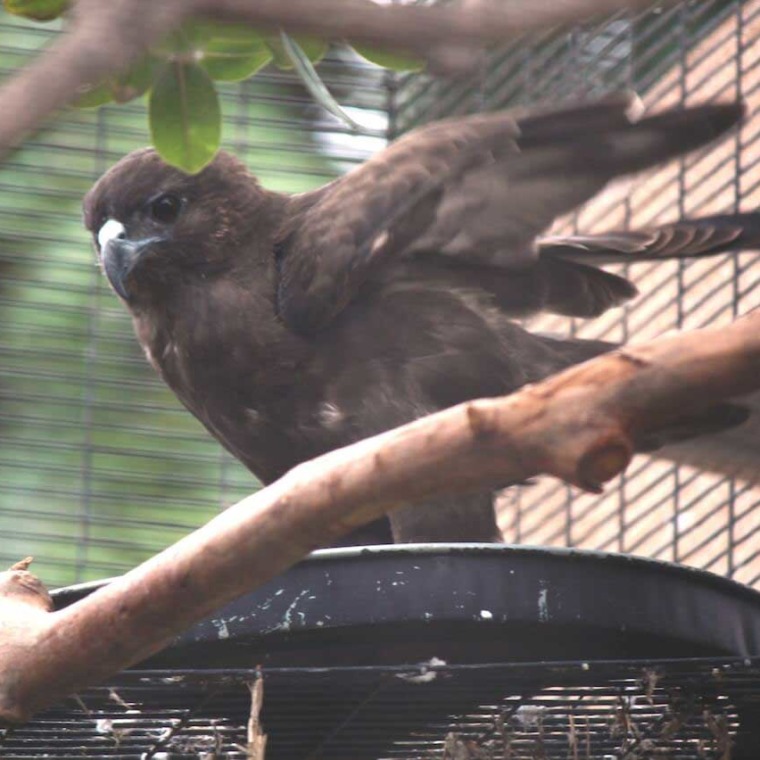
’Io prefer to hunt from tall perches that they use to survey their prey; however, they are known to dive at targets from mid-flight if the opportunity presents itself. are territorial and come together only to breed.


